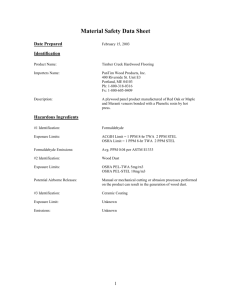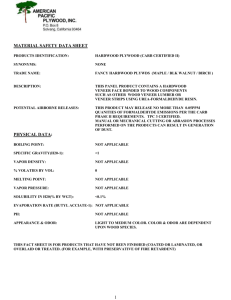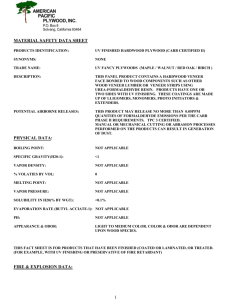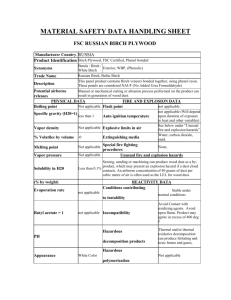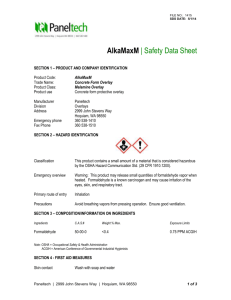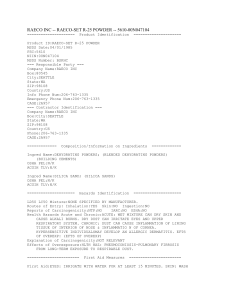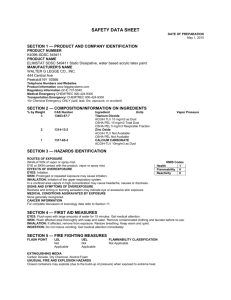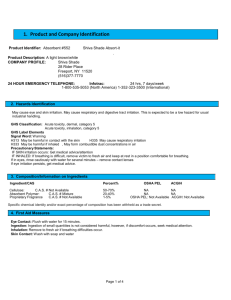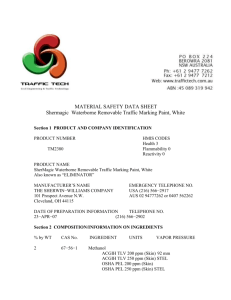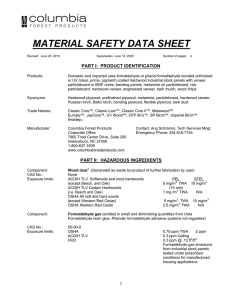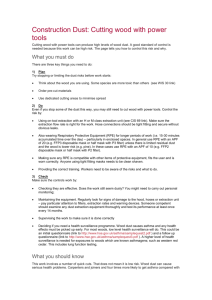Shanghai Senda Fancywood Industry Plywood
advertisement
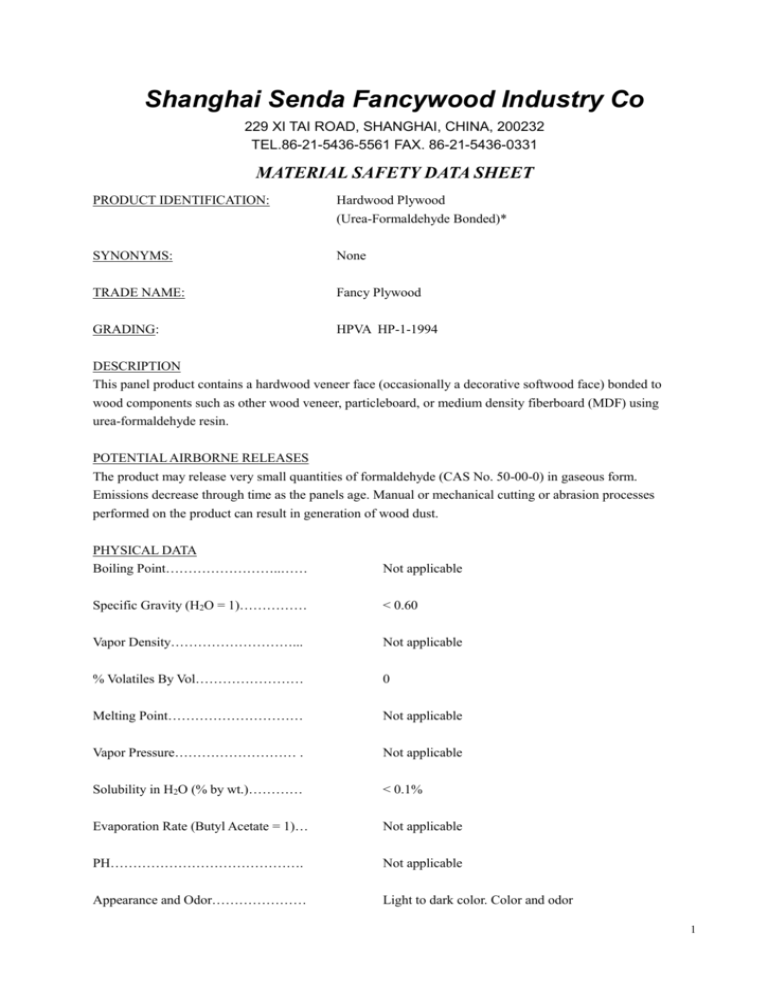
Shanghai Senda Fancywood Industry Co 229 XI TAI ROAD, SHANGHAI, CHINA, 200232 TEL.86-21-5436-5561 FAX. 86-21-5436-0331 MATERIAL SAFETY DATA SHEET PRODUCT IDENTIFICATION: Hardwood Plywood (Urea-Formaldehyde Bonded)* SYNONYMS: None TRADE NAME: Fancy Plywood GRADING: HPVA HP-1-1994 DESCRIPTION This panel product contains a hardwood veneer face (occasionally a decorative softwood face) bonded to wood components such as other wood veneer, particleboard, or medium density fiberboard (MDF) using urea-formaldehyde resin. POTENTIAL AIRBORNE RELEASES The product may release very small quantities of formaldehyde (CAS No. 50-00-0) in gaseous form. Emissions decrease through time as the panels age. Manual or mechanical cutting or abrasion processes performed on the product can result in generation of wood dust. PHYSICAL DATA Boiling Point……………………..…… Not applicable Specific Gravity (H2O = 1)…………… < 0.60 Vapor Density………………………... Not applicable % Volatiles By Vol…………………… 0 Melting Point………………………… Not applicable Vapor Pressure……………………… . Not applicable Solubility in H2O (% by wt.)………… < 0.1% Evaporation Rate (Butyl Acetate = 1)… Not applicable PH……………………………………. Not applicable Appearance and Odor………………… Light to dark color. Color and odor 1 are dependent upon wood species. *This fact sheet is for products that have not been finished (coated, laminated, or overlaid) or treated (for example, with preservative or fire retardant). FIRE AND EXPLOSION DATA Flash point…………………………… Not applicable Autoignition Temperature…………… Not available (will depend upon duration of exposure to heat source and other variables) Explosive Limits in Air……………… See below under "Unusual Fire and Explosion Hazards" Extinguishing Media…………………. Water, Carbon dioxide, Sand Special Fire Fighting Procedures……. None Unusual Fire and Explosion Hazards……………………………… REACTIVITY DATA Conditions Contributing to Instability…………………………… Incompatibility……………………… Hazardous Decomposition Products………………….………… Hazardous Polymerization…………. Sawing, sanding or machining can produce wood dust as a by-product which may present an explosion hazard if a dust cloud contacts an ignition source. An airborne concentration of 40 grams of dust per cubic meter of air is often used as the LEL for wood dust. Stable under normal conditions. Avoid contact with oxidizing agents. Avoid open flame. Product may ignite in excess of 4000F. Thermal and/or thermal oxidative decomposition can produce irritating and toxic fumes and gases, including carbon monoxide, hydrogen cyanide, aldehydes, organic acids and polynuclear aromatic compounds. Not applicable HEALTH EFFECTS INFORMATION Exposure Limits: Formaldehyde……………………… OSHA PEL - TWA OSHA PEL - STEL ACGIH TLV - CEILING 0.335 ppm 0.335 ppm 0.335 ppm 2 Wood Dust (all soft and hard Woods except Western red cedar)… OSHA PEL - TWA 5mg/m3 OSHA PEL - STEL 10mg/m3 Wood Dust (Western red cedar)……. OSHA PEL - TWA Wood Dust (Softwood)……………… ACGIH TLV - TWA 5mg/m3 Wood Dust (certain hardwoods such as beech and oak) …………………… ACGIH TLV - TWA 1mg/m3 2.5mg/m3 Eye Contact………………………… Gaseous formaldehyde may cause temporary irritation or a burning sensation. Wood dust can cause mechanical irritation. Skin Contact………………………… Both formaldehyde and various species of wood dust may evoke allergic contact dermatitis in sensitized individuals. Ingestion…………………………….. Not likely to occur. Inhalation: Gaseous formaldehyde………………. May cause temporary irritation to eyes, nose and throat. Some reports suggest that formaldehyde may cause respiratory sensitization, such as asthma, and that preexisting respiratory disorders may be aggravated by exposure. Formaldehyde is listed by the International Agency for Research on Cancer (IARC) as a probable human carcinogen. The National Toxicology Program (NTP) includes formaldehyde in the Annual Report on Carcinogens. Formaldehyde is regulated by OSHA as a potential cancer agent. In studies involving rats, formaldehyde has been shown to cause nasal cancer after long-term exposure to very high concentrations (14+ ppm), far above those normally found in the workplace using this product. The National Cancer Institute (NCI) conducted an epidemiological study of industrial workers exposed to formaldehyde (published June 1986). The NCI concluded that the data provides little evidence that 3 mortality from cancer is associated with formaldehyde exposure at the levels experienced by workers in the study. Wood Dust…………………………… May cause nasal dryness, irritation and obstruction. Coughing, wheezing, and sneezing; sinusitis and prolonged colds have also been reported. Depending on species, may cause respiratory sensitization and/or irritation. Prolonged exposure to wood dust has been reported by some observers to be associated with nasal cancer. Wood dust is not listed as a carcinogen by IARC,NTP or OSHA. PRECAUTIONS, SAFE HANDLING Formaldehyde: Provide adequate ventilation to reduce the possible buildup of formaldehyde gas, particularly when high temperatures occur. Wood Dust: Avoid dusty conditions and provide good ventilation. GENERALLY APPLICABLE CONTROL MEASURES Ventilation: Provide adequate general and local exhaust ventilation to keep airborne contaminant concentration levels below the OSHA PELs. Personal Protective Equipment: Wear goggles or safety glasses when manufacturing or machining the product. Wear NIOSH/MSHA approved respirator when the allowable exposure limits may be exceeded. Other protective equipment such as gloves and outer garments may-be needed depending on dust conditions. EMERGENCY AND FIRST AID PROCEDURES Eyes…………………………………. Flush eyes with large amounts of water. Remove to fresh air. If irritation persists, get medical attention. Skin…………………………….…… Wash affected areas with soap and water. Get medical advice if rash or persistent irritation or dermatitis occurs. 4 Inhalation…….………………….…. Ingestion…………………………… Manufacturer Name and Effective Date Address Shanghai Senda Fancywood Feb. 27, 2006 Industry Co. 229, Xi Tai Road Shanghai China 200232 Tel: 0086-21-54365561 Fax: 0086-21-54360331 Remove to fresh air. Get medical advice if persistent Irritation, severe coughing or breathing difficulty occurs. Not applicable Supersedes Date Prepared BY Jerry Wong IMPORTANT: The information and data herein are believed to be accurate and have been compiled from sources believed to be reliable. It is offered for your consideration, investigation and verification. The National Forest Products Association (NFPA) makes no warranty of any kind, express or implied, concerning the accuracy or completeness of the information and data herein. NFPA will not be liable for claims relating to any party's use of or reliance on information and data contained herein regardless of whether it is claimed that the information and data are inaccurate, incomplete or otherwise misleading. It is incumbent upon the user to obtain the most up-to-date information. 5
